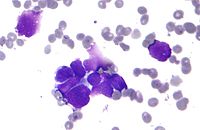
Photo from wikipedia
Long non-coding RNA (lncRNA) such as ANRIL and UFC1 have been verified as oncogenic genes in non-small cell lung cancer (NSCLC). It is well known that the tumor suppressor microRNA-34a… Click to show full abstract
Long non-coding RNA (lncRNA) such as ANRIL and UFC1 have been verified as oncogenic genes in non-small cell lung cancer (NSCLC). It is well known that the tumor suppressor microRNA-34a (miR-34a) is downregulated in NSCLC. Furthermore, miR-34a induces senescence and apoptosis in breast, glioma, cervical cancer including NSCLC by targeting Myc. Recent evidence suggests that these two lncRNAs act as a miR-34a sponge in corresponding cancers. However, the biological functions between these two non-coding RNAs (ncRNAs) have not yet been studied in NSCLC. Therefore, we present a Boolean model to analyze the gene regulation between these two ncRNAs in NSCLC. We compared our model to several experimental studies involving gain- or loss-of-function genes in NSCLC cells and achieved an excellent agreement. Additionally, we predict three positive circuits involving miR-34a/E2F1/ANRIL, miR-34a/E2F1/UFC1, and miR-34a/Myc/ANRIL. Our circuit- perturbation analysis shows that these circuits are important for regulating cell-fate decisions such as senescence and apoptosis. Thus, our Boolean network permits an explicit cell-fate mechanism associated with NSCLC. Therefore, our results support that ANRIL and/or UFC1 is an attractive target for drug development in tumor growth and aggressive proliferation of NSCLC, and that a valuable outcome can be achieved through the miRNA-34a/Myc pathway.
Journal Title: Biomolecules
Year Published: 2022
Link to full text (if available)
Share on Social Media: Sign Up to like & get
recommendations!